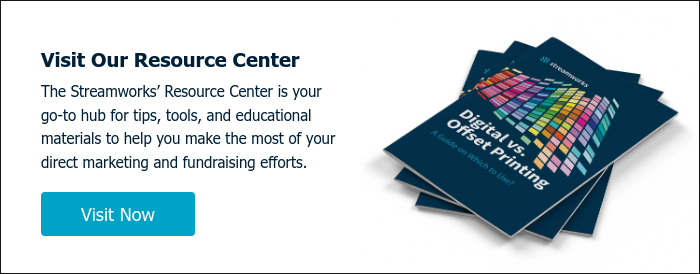Direct Mail Trends 2025: Engaging Gen Z and Next-Gen Buyers
Streamworks Blog
.jpg?width=1000&height=667&name=shutterstock_444082576%20(1).jpg)
As the marketing landscape evolves, so does the role of direct mail in creating meaningful connections with target audiences. In 2025, direct mail is poised for a significant transformation, driven by the need to engage Gen Z and younger generations entering the ideal buyer persona. These digitally native and socially conscious groups demand a fresh approach to traditional marketing strategies. Here are the key trends shaping direct mail campaigns in 2025:
A business owner can use direct mail to share their personal story or a candid message, fostering trust and authenticity that aligns with Gen Z's values. Premium materials and creative design in mail pieces reinforce a brand's message and create lasting printing impressions, helping to capture Gen Z's attention and make the brand memorable. Technology integration, such as QR codes linking to personalized content, enables seamless integration between physical mail and digital experiences, enhancing engagement and connecting with Gen Z's digital habits.
Encouraging user generated content and turning recipients into brand advocates through referral codes or social sharing tools can amplify the impact of a direct mail campaign and build a loyal community. Understanding Gen Z's purchasing behavior and purchasing decisions allows businesses to tailor their mail campaigns to capture Gen Z's attention and drive purchase and purchasing actions. Direct mail campaigns help small businesses and younger demographics by providing a tangible way to connect and build loyalty, while also helping brands reach Gen Z and Gen Z shoppers by standing out in a crowded market and appealing to young people and Gen Zers.
Compared to other generations, what sets Gen Z apart is their demand for authenticity, social responsibility, and personalized experiences—making direct mail a powerful tool when crafted with these values in mind. Service and social responsibility are increasingly important in direct mail for Gen Z, as brands that demonstrate commitment to these causes foster deeper connections. While the internet dominates Gen Z's daily lives, direct mail offers a unique, memorable alternative that can break through digital noise. A well-designed mail campaign can create memorable experiences for younger demographics, ensuring the brand's message resonates and drives lasting engagement.
Here are the key trends shaping direct mail campaigns in 2025:
Introduction to Direct Mail
Direct mail marketing is experiencing a renaissance as brands seek new ways to capture the attention of younger consumers, especially Gen Z. As the first generation of true digital natives, Gen Z’s daily lives are saturated with online marketing and digital ads. Yet, this constant digital exposure has made physical mail stand out as a refreshing and memorable alternative. For Gen Z consumers, receiving direct mail offers a tactile experience that digital channels simply can’t replicate, making it a powerful tool for brands aiming to create a personal connection.
Unlike previous generations, Gen Z values authenticity, social consciousness, and genuine connections with the brands they support. Direct mail campaigns allow businesses to tap into these values by delivering personalized content that feels both unique and meaningful. By using premium materials, bold colors, and creative designs, a direct mail piece can instantly grab the attention of younger consumers and set a brand apart in a crowded marketplace. For example, a mail piece crafted from sustainable materials not only appeals to Gen Z’s eco-friendly mindset but also demonstrates a brand’s commitment to social responsibility.
The integration of technology further enhances the impact of direct mail marketing for Gen Z. QR codes and personalized URLs create a seamless bridge between physical mail and digital channels, inviting recipients to engage with exclusive online content, special promotions, or interactive experiences. This digital integration not only increases response rates but also encourages Gen Z consumers to share their experiences on social platforms, amplifying the brand’s message and fostering a sense of community.
As Gen Z’s buying power continues to grow, it’s essential for businesses to adapt their marketing strategy to meet the expectations of this younger generation. Direct mail campaigns that prioritize authenticity, creativity, and sustainability can help brands connect with Gen Z on a deeper level and build long-term loyalty. As one vice president in the marketing industry put it, “Direct mail is a powerful tool for capturing Gen Z’s attention and creating a lasting impression. By leveraging the latest technologies and trends, businesses can create direct mail campaigns that are both effective and sustainable.”
By embracing the unique strengths of direct mail and integrating them with digital innovations, businesses can create memorable mail campaigns that resonate with Gen Z and set the stage for direct mail success in the digital age.
Hyper-Personalization with a Purpose
Personalization has been a cornerstone of effective direct mail, but 2025 takes it further. Marketers are leveraging advanced data analytics and AI to create:
-
Variable images: Tailored visuals that resonate with individual preferences, such as featuring a recipient's hometown landmarks or favorite color palettes.
-
Behavior-driven offers: Recommendations based on past purchases, online browsing behaviors, or donation patterns.
-
Custom CTAs: Calls to action adapted to recipients' habits, whether encouraging digital interactions for tech-savvy Gen Z or promoting in-person events for younger millennials.
Hyper-personalized content doesn't just grab attention; it builds trust by demonstrating an understanding of the recipient's unique needs and values.
Eco-Friendly Materials and Messaging
Gen Z prioritizes sustainability, and direct mail campaigns are responding with greener practices. This includes:
-
Recycled and biodegradable materials: Using paper from sustainable forests and environmentally friendly inks.
-
Eco-conscious messaging: Highlighting sustainability efforts within the campaign to align with Gen Z's values.
-
Minimalist design: Reducing waste by limiting unnecessary components, such as oversized mailers or excessive packaging.
Interactive and Digital Integration
Direct mail is no longer a standalone medium. Integration with digital platforms enhances engagement and tracks effectiveness. Key strategies include:
-
Personalized QR codes: This leads to curated landing pages or AR experiences tailored to the recipient.
-
Augmented reality (AR): Allowing recipients to visualize products or experiences through their smartphones.
-
Social media tie-ins: Encouraging recipients to share their mailer experience online, fostering organic brand buzz.
Storytelling Through Design
Younger generations respond to narratives that are authentic and relatable. In 2025, direct mail designs emphasize storytelling by:
-
Chronological layouts: Guiding recipients through a journey, whether it's a brand's mission or a customer success story.
-
Rich visuals: Using bold colors, dynamic typography, and eye-catching imagery to reflect Gen Z's digital aesthetics.
-
Interactive elements: Including tear-off sections, pop-ups, or scratch-off panels that invite recipients to participate in the story.
Data-Driven Predictive Campaigns
With the proliferation of AI tools, predictive analytics are essential for crafting targeted campaigns. Marketers can:
-
Identify trends: Predict what products or services will appeal to specific demographics.
-
Optimize timing: Ensure mailers reach audiences at the most impactful moments, such as birthdays or life milestones.
-
Anticipate next steps: Suggest relevant follow-up actions based on recipient engagement.
Short-run and Localized Campaigns
Gen Z values authenticity and connection to their community. Direct mail campaigns are adapted by:
-
Localized messaging: Tailoring content to reflect community-specific interests and events.
-
Short-run printing: Creating smaller, highly targeted batches that can be quickly adjusted based on performance.
Inclusivity in Messaging and Representation
Younger generations expect diversity and inclusion to be a standard, not an exception. Direct mail campaigns in 2025 reflect this:
-
Culturally sensitive imagery and language: Ensuring all recipients feel represented.
-
Broad accessibility: Incorporating features like Braille, large-print options, or multilingual mailers.
Preparing for the Future
Marketers must blend innovation with authenticity to capture the attention of Gen Z and the next generation. By embracing these trends, direct mail will remain relevant in 2025 and become a powerful tool for cultivating lasting relationships with younger audiences.
As the year unfolds, these trends will continue to evolve, driven by technology and shifting consumer expectations. For marketers prepared to innovate, direct mail provides a distinctive opportunity to bridge the gap between physical and digital experiences, making a lasting impression on tomorrow's audiences.


.jpg?width=352&name=770X310-LeadGen-V2%20(1).jpg)

